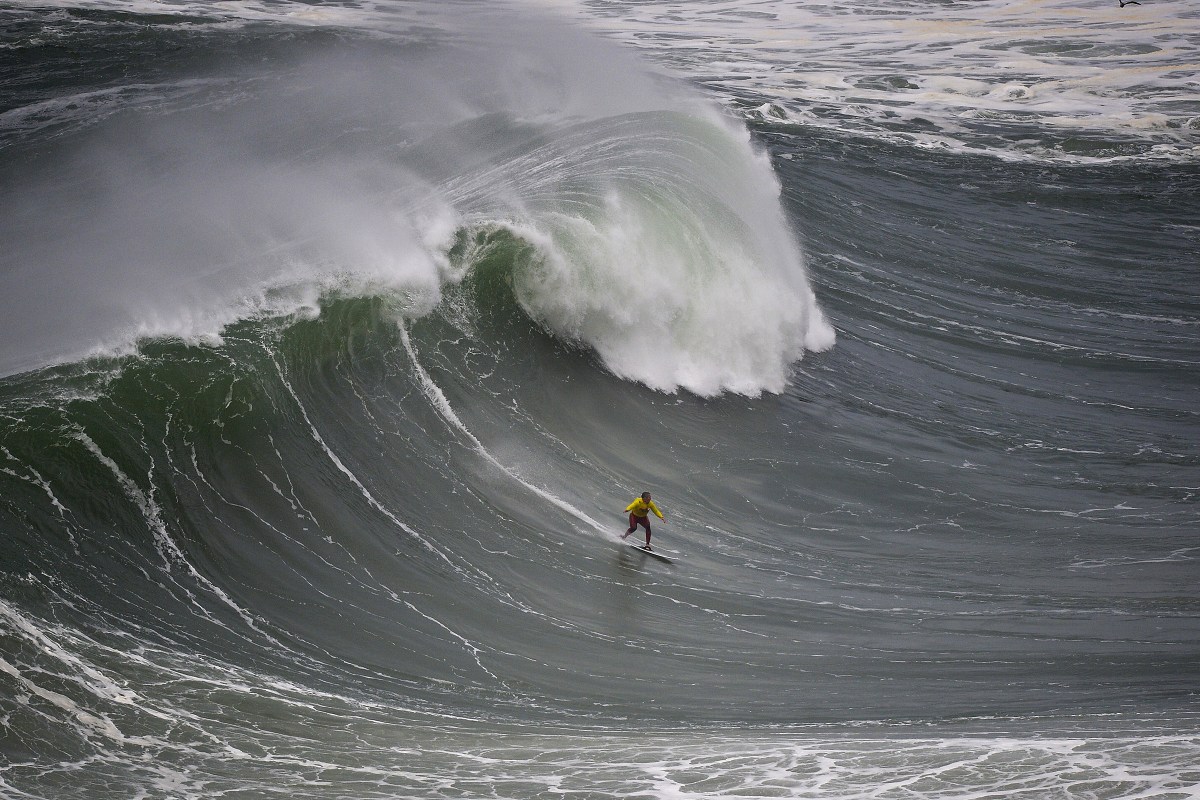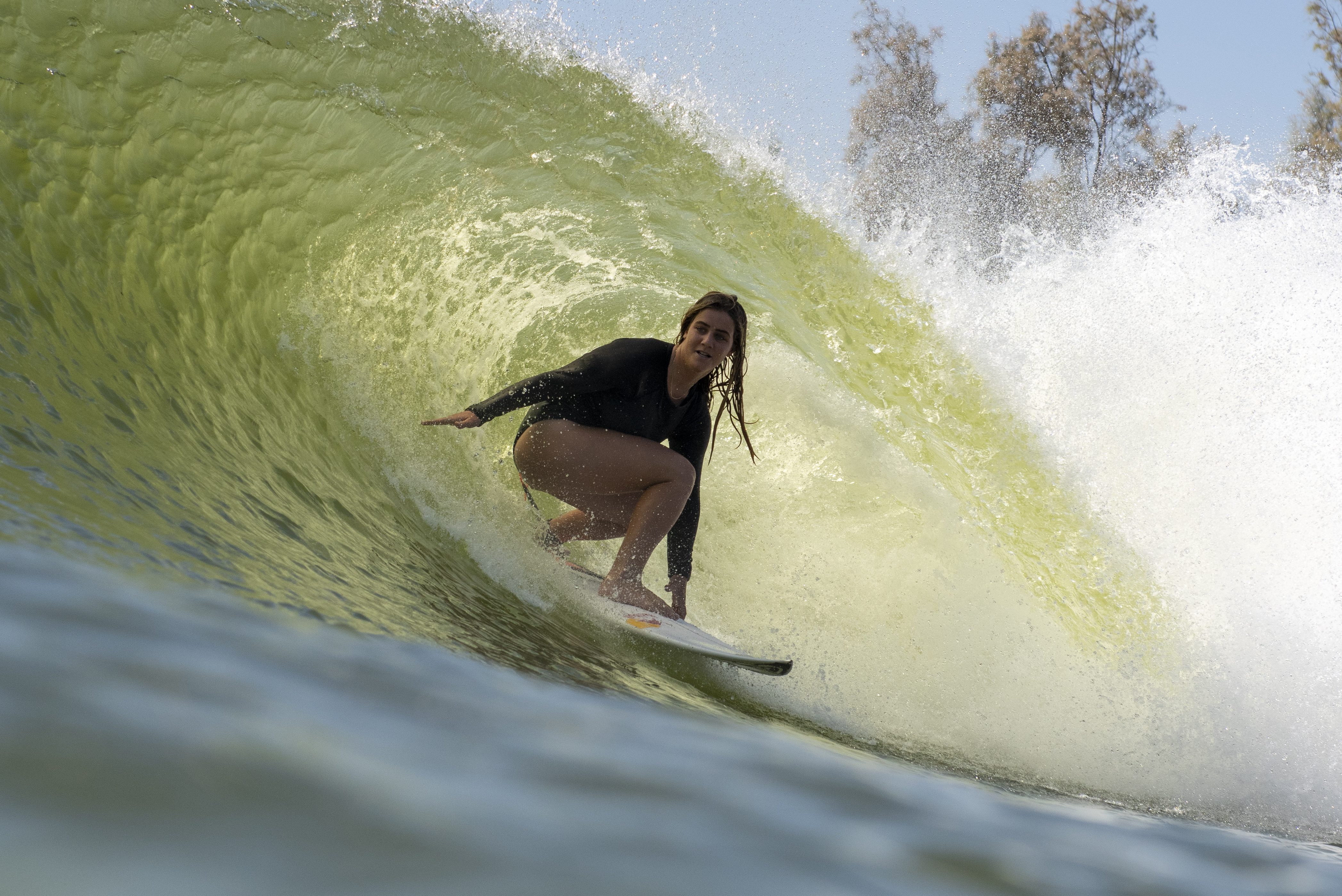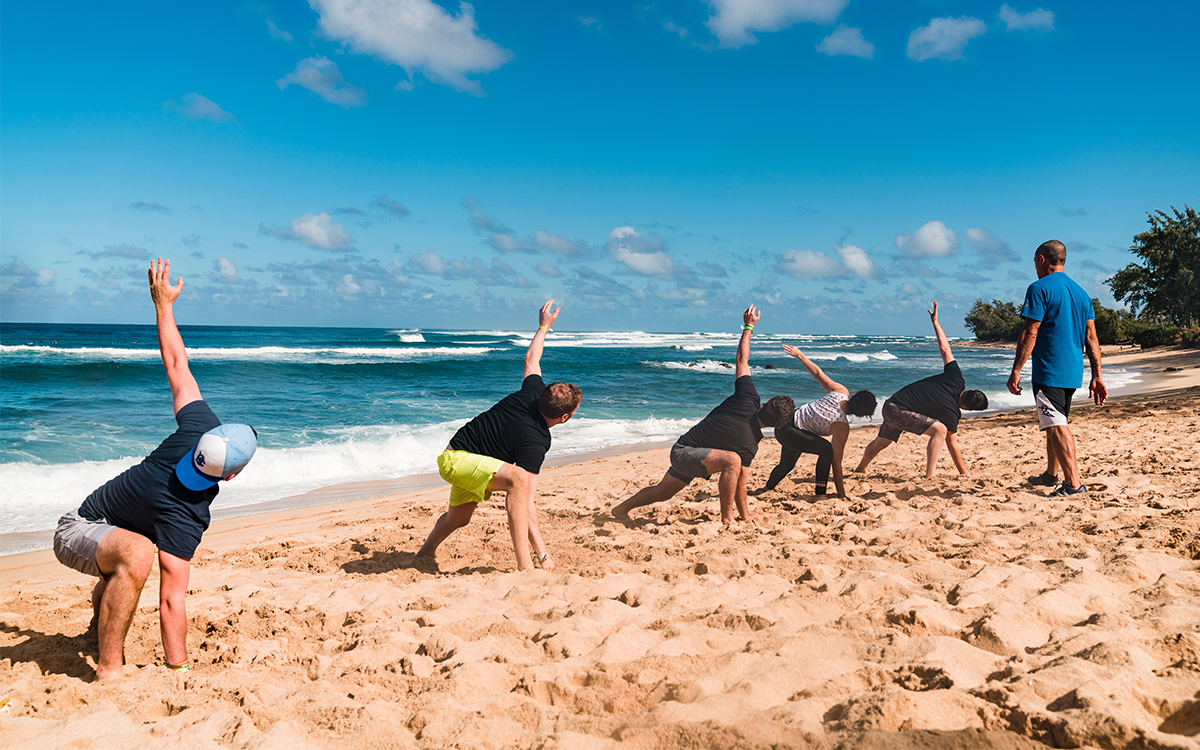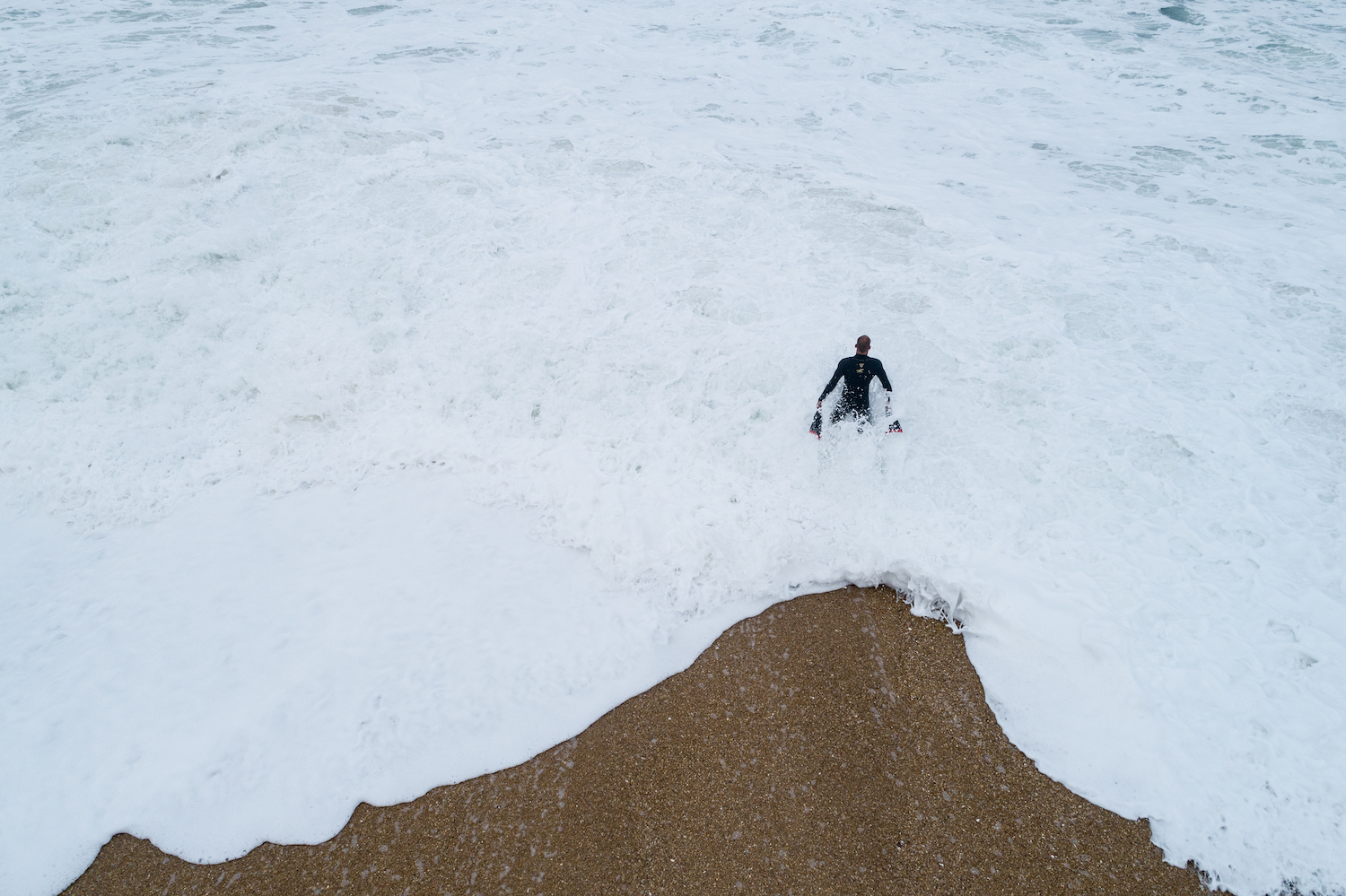It’s a sunny Tuesday morning in Hawaii and I’m on a jetski with Garrett McNamara and his family. Well, technically I’m on the phone with McNamara and it’s a dank afternoon in central New York, but still.
“We’re following some dolphins right now,” the 54-year-old big wave surfer relays with his trademark ebullience.
Not wanting to interrupt their outing, I offer to call back.
“No, it’s fine,” he says. “I can actually multi-task. One of the only men that can do that … Not!” He releases a long, benevolently maniacal laugh.
McNamara’s charisma is a big reason I was excited to speak to him. But I was also pumped to ask about 100 Foot Wave, HBO’s six-part documentary that concluded last night.
In 2011, McNamara caught a monster wave at Praia do Norte, the now famous beach in Nazaré, Portugal. Only a handful of people saw it with their own eyes. Fellow surfer Andrew “Cotty” Cotton towed McNamara onto the wave with a jetski. On the bluff overlooking the break, McNamara’s wife and manager, Nicole, watched from Nazaré’s iconic 16th-century lighthouse. She was joined by the dedicated team of locals who had courted her husband, emailing him several years earlier with an invitation to come see if their wave was any good.
A skeleton crew of photographers, endemic and essential species in the pro surfing ecosystem, were in the perfect position to capture the ride. With a measured height of 78 feet, it was the biggest wave ever surfed.
100 Foot Wave tells the story behind that record wave as well as McNamara’s quest to find an even bigger one. It features some of the most high-resolution, jaw-dropping surfing footage ever produced. But to bill the series as adrenaline porn is to sell it short.
Drawing from a deep well of new and archival material, director Chris Smith (Fyre: The Greatest Party That Never Happened) renders a gripping narrative about the confluence of people and place. The series artfully integrates multiple origin stories: the birth of big wave surfing, Nazaré’s transformation from a tiny fishing village to surfing mecca, and McNamara’s unlikely path to becoming the hero of both.
For a long time, McNamara occupied a liminal space in the surfing world. He was in the club, but also an outsider. In the early days, he was overshadowed by his younger brother Liam, the bad boy of pro surfing, and never really broke through in any of the major competitions. When Laird Hamilton first pioneered tow-in surfing, McNamara was right there riding the same waves. But the number of guys who truly made it as pro surfers was miniscule, and he struggled to make ends meet, so he abandoned his dream and opened a surf shop.
It was a successful business, but McNamara was miserable. He wasn’t surfing. After much introspection, he decided to manifest the life he wanted. He closed his shop when he turned 35 and started training full-time. In 2002, he won the Tow Surfing World Cup at Jaws in Maui. The $70,000 purse that he split with his tow-partner allowed him to keep the dream alive. The following year, once again at Jaws, he got barreled in a massive wave. Everyone assumed he was swallowed whole until, after what felt like an eternity, he shot out of the frothy water with his arms raised triumphantly.
The Jaws barrel immediately became one of the most famous waves ever ridden, and McNamara never looked back. He threw himself into chasing the biggest swells on the planet, which is how his path converged with Nazaré.
A lot of people ask McNamara if he’s crazy. They assume that he must have a screw loose, that he’s trawling the same self-destructive waters as Captain Ahab. But after speaking with McNamara, that strikes me as a misreading.
He does seem to be wired differently than the “average person,” whoever that is, but it has nothing to do with sanity. It’s more about consciousness and connectedness, to the world and himself. Deeply spiritual, he’s attained a level of inner and outer peace that allows him to go through life with total conviction and comfort. It’s the kind of harmonious existence that’s difficult for most of us to fathom. But that doesn’t mean we can’t try.
Our conversation has been edited for length and clarity.
InsideHook: What’s it like knowing that you and your team helped make Nazaré the most famous big wave spot on the planet?
Garret McNamara: The wave was always there, so I don’t think it’s us. People just know about it now. But I’m very proud and honored that the people of Nazaré chose me. It was super lucky. They’ve become just like family.
Big wave surfing is inherently risky, but why are the conditions at Nazaré uniquely dangerous?
There’s no safe zone. Your initial tow, the guy who’s towing you, has to get you. And if he can’t, then it’s best to have a second ski for backup that shadows you. We put that rule in place in 2011 and a lot of people disregard it. So then a lot of us have to go rescue them when they should have been more prepared. It puts all of us in danger and harm’s way when they’re not doing the things they’re supposed to be doing.
Also, I wasn’t very involved with the WSL [World Surf League] for all the years, but after that accident happened [with Alex Botelho], we got more involved to make sure that doesn’t happen again.
Do you feel extra responsible for everyone’s safety since you’re a big reason they’re in Nazaré?
Yeah, I did. But I went and had a talk with the navy. They told me, “Garrett, once they’re in the water, you’re not responsible and we’re not responsible, so don’t even think twice about that.” So I took that to heart and released feeling responsible.
But also, I’m an open book and I love to share, but I don’t like to impose. So if anybody has questions, I’m there for them. Anybody needs help, I’m there for them. But I don’t like to impose and it’s tough when you’ve got all different kinds of powers that be and politics and contests. I kind of watched it all for a few years, and now I’ve decided to get more involved.
You didn’t surf the February 2020 Tow Challenge because your foot was still injured. At first, it looked like the decision — to surf or not to surf — was tormenting you. But then you just had this moment of clarity, like “I’m not ready,” and then you seemed at peace. I’m curious about how your relationship with risk has evolved over the years.
Definitely more patient. I have a lot more patience. Before, I had to be on every swell. Like there was just a giant swell in Tahiti, the biggest one in about 10 years. Normally, if I had the ability to go and I didn’t, I would be on suicide watch. But I was sitting at home very comfortable and very at peace. It used to be that I felt I had to get the best wave of the swell or something super good for the companies I’m working with to be able to get another contract next year. We’ve been working very patiently and strategically and things are going very well, so I don’t have to chase every swell. Even though I still have a desire to, it’s not the end of the day if I miss it.
There’s this wild line from Cotty in one of the earlier episodes. I’m paraphrasing, but he basically says, “I’m not afraid of dying, I’m afraid of not being able to surf again.”
Yeah! I like that one. Classic, right? That’s Cotty. And you don’t get Cotty to say much. To have him say that was great.
Is that something you relate to?
No, I’ve never had a desire to die surfing. I know that I’m never gonna die surfing as long as I prepare. Actually, you know what, before I had children, I didn’t mind if I died surfing. I’d rather just surf every wave and if I passed it was okay. But once I had children I changed my mindset. I am not gonna die surfing and I’ll be there for my family.
Are you thinking about your family when you’re surfing?
No, I’m just thinking about the moment and doing the best I can to enjoy every experience in the water. When I was underwater getting pounded after hitting my head [in Indonesia], that was one of the first times I thought about my family and if this was worth it.
Fear is a recurring theme in the documentary, and I’m wondering how you’ve dealt with it throughout your career. Two key moments we see are when you surfed glacial tsunamis in Alaska in 2007 and then your wipeout at Mavericks in 2016. How did those experiences affect your relationship with fear in different ways?
When we went to Alaska, I still had some fear in the ocean. After Alaska, I had none, because I got so overwhelmed with the possibility of dying that it just, I don’t know, blew some fuses or something. I couldn’t get the rush anymore. You get the rush when you’re afraid and it’s so exhilarating. I got comfortable in the ocean and I basically chose not to be afraid anymore.
Then I got the injury [at Mavericks] and it started preying on me. All the pain, how long it took to recover, and I’m still working through scar tissue. So I was battling with whether I was going to enjoy it anymore or not. And then I had a really good wipeout. Where was it? Oh yeah, first at Nazaré. I got a really good wipeout. And then later that year, I got another really big one at Jaws. Both of them I enjoyed. But it was not quite as comfortable as it used to be.
Can you describe what a big wipeout feels like and also what part of it you, uh, enjoy?
A big wipeout is like being in a car crash, a really heavy car crash, that lasts for like 30 seconds to a minute. Not just one big hit. It just keeps hitting. And then you go down so deep and it’s like you’re in a washing machine on spin cycle. You’re very dizzy and you don’t know which way is up half the time. Luckily we have the floatation suit. And … what was the other part of the question?
Uh, what’s enjoyable about that?
When you have no control and you just have to let go and accept. So then you end up getting the rush when you’re under there with no control. You never know what’s going to happen. If you’re riding a wave and you’re making it, you’re great. But if you’re underwater getting pounded, you don’t know when it’s going to let you up. You don’t know what you’re in for. So it makes you really feel alive.
I’m not a surfer, so pardon the ignorance, but what percent of rides in big wave surfing end with wipeouts compared to making the wave?
It depends on how hard you push it. Waves have barrels and most of us like to be in the barrel. If you’re pushing it really hard to get in the barrel, you’re on that 50-50 line where you’re gonna make it and get the wave of your life or you’re not gonna make it and get a good pounding underwater.
It all depends on your approach and what you’re looking to achieve. Some guys will play it real safe and make 90, 100 percent of their waves. Other guys will put it on the line a little more and they’ll make a lower percentage. Other guys will put it all on the line every wave and it’s 50-50. I was in the 50-50 realm for a while. I’d usually put it all on the line, depending on the spot and the size of the swell. But I like to complement a wave. Never conquering a wave, always complementing the wave and riding it as deep as possible and preferably getting into the barrel.
When you’re bombing down the face of a wave, you look like a snowboarder trying to escape an avalanche. Is that an apt comparison?
Yeah, it’s exactly like that. It’s like a snowboarder or a skier going down an icy mogul. Almost out of control, barely holding on, and it’s a big mogul — five or six feet — and the whole mountain is moving. And an avalanche is chasing you.
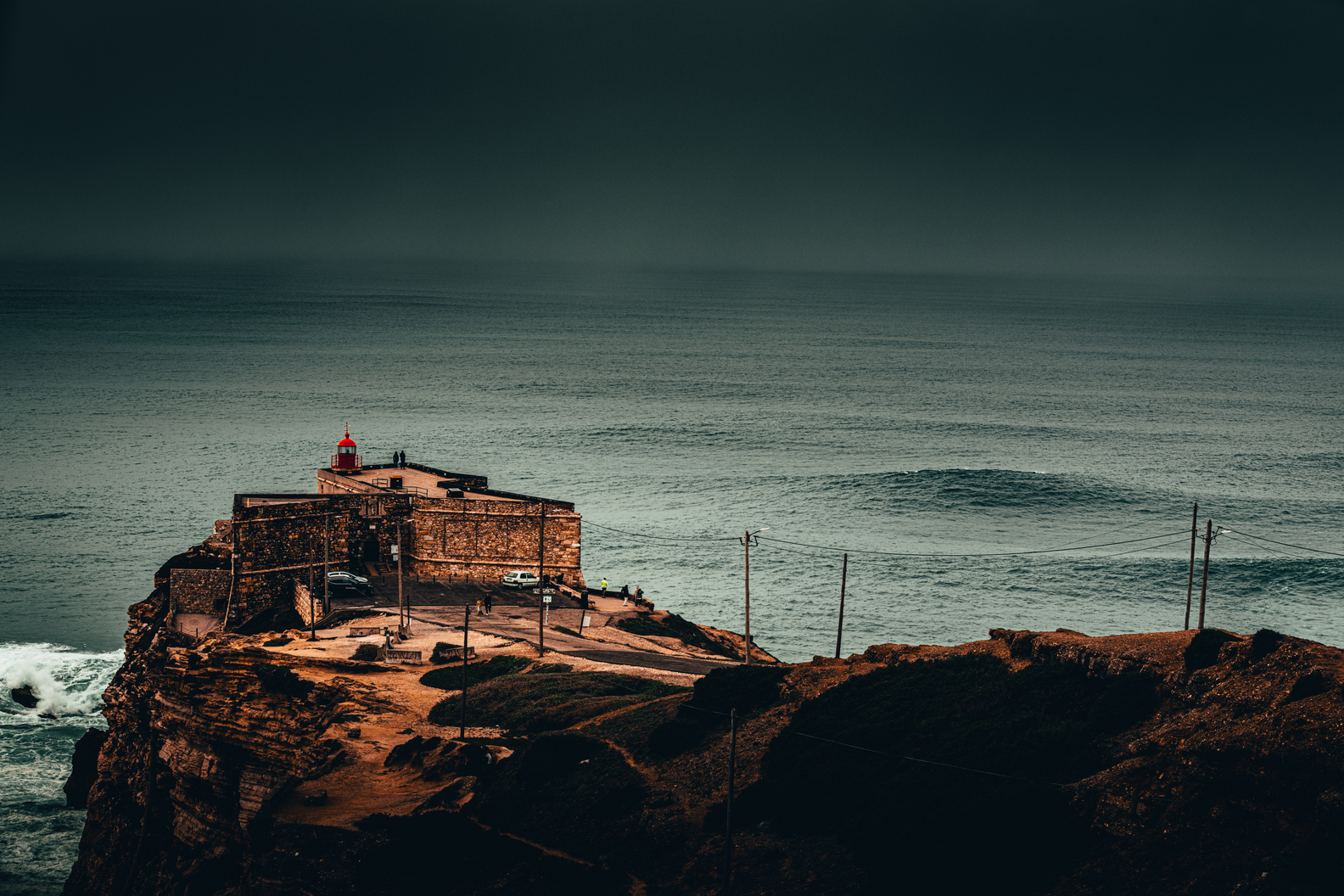
You talk a lot about being in the moment when you’re in the ocean. How do you put yourself in that state of being totally immersed in the present?
Smell, see, feel, observe. Just connect. The best way that I connect is I do a little breathing exercise where I breathe all my stale air out and then take a huge breath in. I do that three times with my eyes closed. On the third breath I open my eyes and feel myself connecting to the universe and I’m totally reset. It works amazingly for going to do a speech or going into a business meeting. Anything you really want to have a clear head and go in with an open heart and really feel your way through rather than think.
Are there other settings in your life, beyond the water, where you’re able to harness this mindset?
The ocean is where I really feel the connection. I’ve made myself do it everywhere. There are different plant medicines that can help you really feel things because we’re so conditioned to not feel. We’re kind of like robots and we don’t even realize it. Plant medicine helps you feel what’s important and connect to yourself and everything around you. It’s a scientific fact that we’re all energy and we’re all connected. You don’t need plant medicine to feel that. You can do it through meditation. You can do it with a different shaman, guru, whatever religion you’re in, there’s ways of reaching it through different practices.
I’ve heard you say that the 100-foot wave is out there and you’ve ridden it many times in your mind. Can you describe what that ride feels like?
I get pulled in with a jetski. Too big to paddle. As I let go of the rope, I fade back to the left. Wshhhh [carving noise]. Then I fade back to the right. Wshhhh. I fade back to the left. Whheeeshhh [higher pitched, like a swooping bird of prey]. And I get to the bottom, and I do a big bottom turn, and I pull up right into the pocket. I don’t get deep by running, but then the barrel passes me a little bit. And then I come out into the channel with my hands up in the air and I say, “Thank you God!” And it’s a thousand feet deep in the channel in Nazaré where the 100-foot wave breaks, so it’s super safe, probably the safest place to ride a 100-foot wave.
How are you feeling right now, like physically and in terms of your readiness to ride that wave?
My legs are stronger than they’ve ever been, so my foundation is perfect. My back, I have a little teeny kink in my back that’s been coming and going. I have a little kink in the neck that’s been coming and going. Those two little sore spots, they’re not bad, but it’s a dull, irritating pain that you don’t want to live with. I don’t feel like I should be going out in these giant waves when I have these two little things going on, so I’m working on them.
The back feels perfect today, it’s been perfect for the last week. The neck’s still a little bit of a challenge. I’ve got HBO Max neck from laying down and watching my computer. Seriously, that’s how I get it. So I’ve got to refrain from watching anything before I go to bed.
Speaking of HBO, I heard they just picked up a second season—
Do you have an iPhone?
Yeah.
Can you accept?
Accept?
At this point, my phone beeps with an incoming FaceTime call. The screen flashes a fuzzy blue, but the signal isn’t very good. “Check out those dolphins,” Garrett croons right before we lose connection. A minute later we’re back on an audio call.
Hey Garrett, you there?
Hey, sorry. Did you see the dolphins a little bit? [My kids] are swimming with the dolphins right now. So we ran into a turtle, and my wife was swimming, and the turtle came straight up to us. And then it sat looking at her, face-to-face like a couple inches apart. For a whole minute!
That sounds like an incredible moment. I don’t want to take any more family time, so thanks again for talking. And congratulations on HBO renewing 100 Foot Wave for a second season.
Thank you. Yeah, that was amazing. Too good to be true.
All six episodes of 100 Foot Wave are currently streaming on HBO Max (watch them here). McNamara is currently preparing to film the show’s recently green-lit second season.
Whether you’re looking to get into shape, or just get out of a funk, The Charge has got you covered. Sign up for our new wellness newsletter today.
